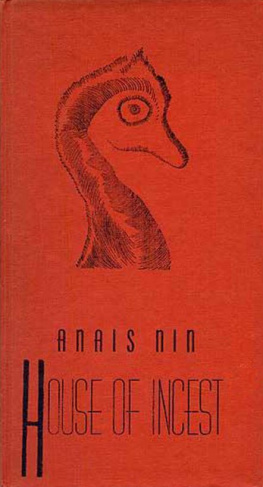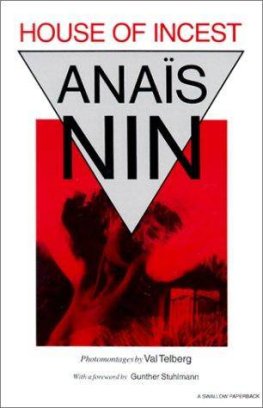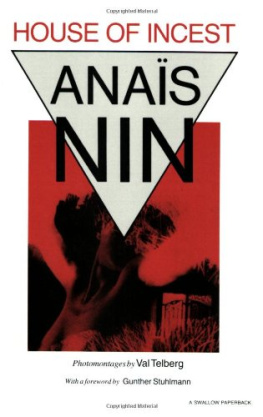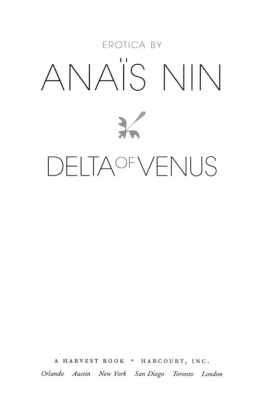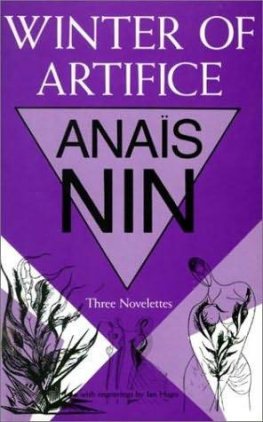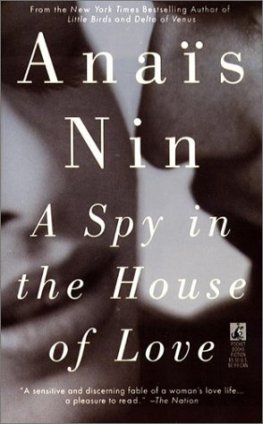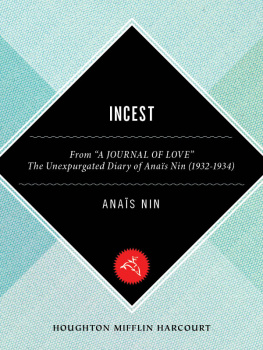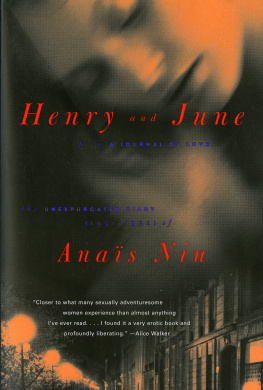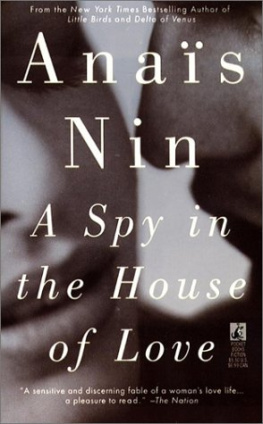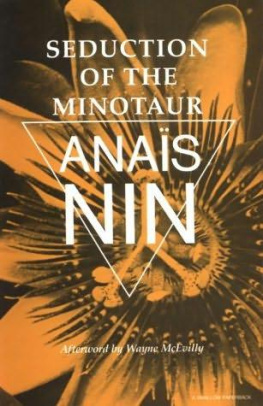TheWinter of Artifice
Anais Nin
Derivedfrom The Winter of Artifice: a facsimile of the original 1939 Paris edition
(c) 2007 Sky Blue Press
To Nancy and Larry with love.
INTRODUCTION
From the publication of her first book in1932 until the mid 1960s, Anais Nin was an obscureauthor who published books with, often, small presses, and short fiction inlittle magazines. With the appearance of The Diary of Anais Nin, 1931-1934 (1966), however, she became well known, and thenincreasingly popular as more volumes of her diary were published. The number ofher books published since her death in 1977 confirms that her appeal continues.At least twenty books of new or mostly new material have been published as oflate 2006. These include nine volumes of her diary, four of them identified asunexpurgated (these four contain some previously published material); threevolumes of correspondence (with Henry Miller, David Pepperell, and Felix Pollak ); two volumes of erotica, plus five books ofselections from them, one illustrated with photographs and another withartwork; and a collection of stories. Another volume of erotica has beenattributed to her and her friends on the basis of unconvincing evidence.Additionally, some short pieces and selections from works published duringNins lifetime have been collected and published as books, and one novella hasbeen published under its own title. Such a substantial number of posthumouspublications begs the question of whether worthwhile Nin writing remainsunavailable. Indeed so. Nins third book and second volume of fiction, TheWinter of Artifice, has not been republished since its initial appearancein 1939. At least one serious reader considers this collection of threenovellas Nins major fictional accomplishment. Writing to Nin in 1960, Felix Pollak states, I stillink it isyour best book, that unexpurgated version magic, entrancing piece of writing(Nin and Pollak 1998, 152).1 Hisassessment is debatable, though reasons for the significance of the book are notarguable: the novellas present several key characters dealing with emotionalissues (a central focus in Nins fiction generally), they serve to illustrateHenry Millers influence on Nins prose, they indicate how Nin used diarymaterial in her fiction, and theyprovide a basis forexamining Nin as evaluator and reviser of her work.
Djuna , Lilith,and The Voice were all published for the first time in The Winter ofArtifice. Djuna has never been republished inits entirety; the other novellas appear in every edition of Winter ofArtifice, as Nin later named the collection, though she revised them aftertheir 1939 publication and changed the title of one of them.2
Set in Paris, Djuna concerns Djunas involvement with Hans and Johanna, acouple married unhappily. Djuna , the narrator, is awriter attracted to impoverished Hans because she considers him highlyintelligent and admires the manuscript he struggles to complete. His noveldepicts a character inspired by Johanna, who objects to his harsh portrayal ofher. Although Djuna and Hans are lovers, she viewsherself primarily as the nurturer of his talent, an aspect of Hans that Johannadoes not value. When Johanna returns to Paris after having been away for thefirst two-thirds of the narrative, she and Djuna develop a closeness that becomes physical to the degree that they kiss andfondle. The night they spend together in bed concludes the novella.
Despite the drama surrounding Djuna , Hans, and Johanna, including the tension between thespouses, the novella mainly deals with the narrators quest for contentment.Although Djuna does not identify her problems, sheacknowledges some of her deficiencies: lying to Hans so he will not think herordinary, assuming any role in order to accommodate him, and wanting to beloved while remaining ultimately unknown.
Johanna appeals to Djuna because Hanss wife possesses traits that Djuna lacks, needs, and desires. These include forthrightness and the ability to actdecisively. Even though the two women are attracted to each other and, takentogether, constitute a complete person, Johanna does not satisfy Djuna . Why? Because in loving Johanna, Djuna embraces the desired, unrealized, unformulated half of herself. In order togain emotional equilibrium, Djuna must unite with hertrue opposite, a man, as she implies after characterizing her love for Johannaas self-love, as narcissism: What I loved to-day [herself in Johanna], far,far above this self, was Hans. Hans, the other (Nin 1939, 85).
The novella concludes without resolution.Johanna plans to leave Hans for another man. If she does, Djuna will presumably have unrestricted access to Hans. A life with him might helpsolve her problems. Yet if Johanna does not leave Hans, Djuna must decide whether to continue her involvement with him on a less-than-idealbasis by sharing him with Johanna or leave him, hoping to find someone tosatisfy her needs.
The second novella, Lilith, focuses on thenarrator, Lilith, and her problems that result from her fathers abandonment ofthe family two decades earlier, when she was ten years old. The reunion of thedaughter (a writer) and her unnamed father (a musician) in France is theoccasion of Liliths narrative, although the text does not indicate what inspiredtheir meeting.
Any child could be expected to interpret thepermanent absence of a parent as rejection, especially after the parent treatedthe child insensitively when the family was intact, as happened with Lilith.Her father terrified her; he thought her ugly. His absence affected her to thedegree that her life has been lonely, that she has been incapable ofappreciating joyous moments, and that she has acted against her own bestinterest. As a way of retaliating against her demanding, perfectionist father,the adult Lilith violated their shared tastes and preferences in order tooffend him. She did this by, among other things, loving only poor men, seekingugliness, and courting danger. The effects of such actions on her are unknown.
Despite her fathers unfeeling treatment ofher, the mature Lilith knows that her father acted as he did because of his ownproblems. She realizes that he was an inadequate parent partly because he lostfaith in love after being betrayed by his betrothed, who is not identified. Shealso comprehends that what she perceived as his abandonment was an attempt tosave himself from an untenable marriage by fleeing it. As a result of these awarenesses , Lilith forgives his fatherly shortcomings.
Understanding her fathers actions does notmean that Lilith should grant his every wish, however. Because of the effectsof his fathers favoring of a daughter over him during his own childhood,Liliths father has been jealous of Liliths life independent of him. Withinthis context, he thinks that, in a sense, his daughter has abandoned him.Partly to protect himself against the pain that this perception causes, heimplies that she should devote herself to him. His desire is unreasonable. Ifshe commits to him, disaster would result not only because she would lacksignificant interaction with other people, but also because father and daughterare too similar. As Djuna learns in the firstnovella, Lilith knows that one must unite with ones opposite, or at least withsomeone significantly different from oneself. Wisely, she does not dedicateherself to her father.
Although Lilith understands and forgives herfather, she discovers that she no longer loves him. She likens the demise ofher love to the death of her fetus, at a time unspecified. As it was dead, thelittle girl in me was dead too. The woman had been saved. And with the littlegirl died the need of a father (Nin 1939, 197). Lilith has liberated herselffrom the oppressive influence of her father and gained a healthy sense of herown individuality and independence. As a result, she will presumably lead amore fulfilling life than previously.
Next page

